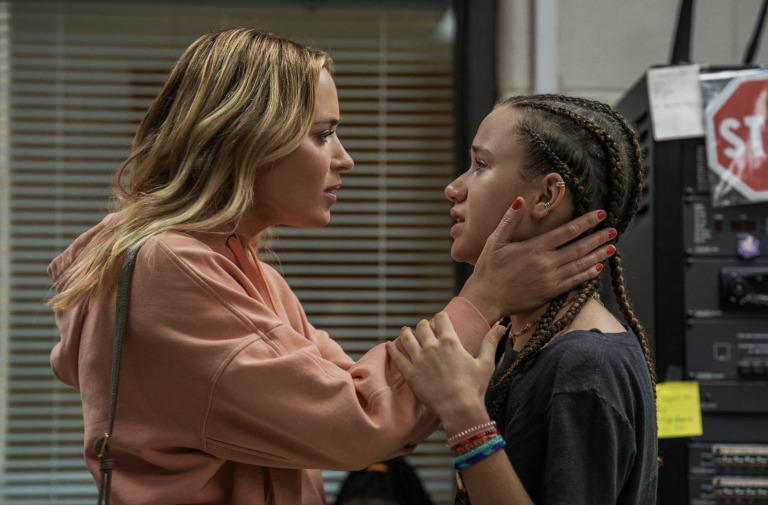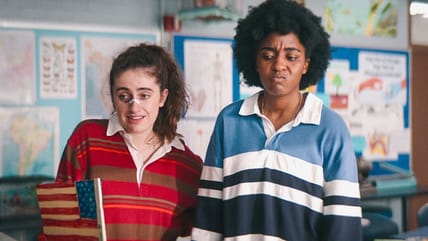
As the opioid crises continues to plague families across the nation and the world, Hollywood has come out with yet another film delving into the world of opioids, big pharma, and shady prescriptions that ultimately catch up with those who are providing them. Pain Hustlers, starring Emily Blunt and Chris Evans focuses on a mother who’s just trying to do well by her child and herself, and ends up diving into the world of big pharma and the unfortunate dark side hidden beneath the surface. Continue reading for our Pain Hustlers review.
RELATED: Where to Watch May December? Everything You Need to Know
What Is Pain Hustlers Based On?
Pain Hustlers the movie is based on the nonfiction book titled the same name by Evan Hughes, but it is also based on a real-life drug scandal. A fentanyl-based drug company named Insys did face consequences for peddling through “speaker programs,” and they marketed a fentanyl spray for the management of pain. Hughes’ book also details how the company sold the drug, including the practice of hiring attractive sales reps and bribing medical practitioners, all so they could get more sales and money.
Though the film Pain Hustlers is still a highly fictionalized work, some of the characters in the movie do share similarities to their real-life counterparts, such as Insys being founded by billionaire Dr. John Kapoor who is the inspiration for Jack Neel (Andy Garcia) in the film. The drug Subsys was renamed to Lonafen, and the company Insys itself was renamed to Zanna for the film adaptation, but still highlighted the misuse of fentanyl-based pain management.
Pain Hustlers Review: Breaking Down Plot, Setting, Characters
The Shady Side of Pharmaceuticals

Ah, the plot of the movie. A woman (Emily Blunt) is trying to find a better life for her and her daughter, and ends up stumbling upon an opportunity to sell medication to doctors for a commission. Unfortunately, the medication is highly addictive due to the traces of fentanyl, but Blunt’s character continues to climb in the growing company until the dangers far outweigh the potential benefits. This leads Blunt to have a moment of clarity, especially as her daughter needs surgery, to change her ways and get out of the business while she still can.
I feel the plot was delivered pretty well, and there were some points where my jaw dropped in disgust and surprise, but there wasn’t anything that made me think holy crap, that’s unbelievable. The truth is, there have been several movies covering both pharmaceutical companies and the opioid epidemic, and even some documentaries as well. There just wasn’t anything jumping out at me that would drive me to dig into the world of corrupt pharmaceuticals or opioids, because I already know it’s bad.
I think if there were new elements or more pushback from the doctors the movie could’ve been more interesting, or even adding depth to each character’s backstory and why they were in this specific position. Of course we know why Blunt’s character is there, but not anything else about the remaining characters in the movie.
Warm Up in the Southeast

Set in Florida, the balmy weather sets the stage for elaborate “speaker programs” and scenic views at each of the character’s houses. It doesn’t really matter much to the movie where the company is based selling these addictive products, because it happens all over the country. The focus was more on the plot and the characters, but I did enjoy the setting in Florida. The stark difference between poverty and wealth is strong in the movie, present in the hotel-like living spaces Emily Blunt starts out in and transitioning to million-dollar suites showing views of the Gulf Coast.
I wouldn’t really change anything about the setting, as it did its job portraying the plot and characters in a good light.
Greed Is the Goal

Each and every character in the film has greed for something, and that is what really drives this movie. For instance Emily Blunt’s greed is for money and putting her and her daughter in a better spot. This drives her to sell addictive drugs and continue to do so in order to get more profit. Chris Evans’ character has a similar greed, but to the point that he only sees the numbers and success, not the people he is hurting or killing along the way. Even Catherine O’Hara’s character has greed, and that is for someone to enjoy her skin products and to make some money.
All of this greed feeds into the pharmaceutical companies and opioids to create a perfect storm. A group of people want to get rich and earn respect, even though their practices are at best questionable. I liked most of the actor’s performances, but the characters did feel flat because they were all greedy for something. The only one that really wasn’t greedy was Blunt’s daughter in the film, and that’s because she was more worried about school and her seizures than anything else.
CHECK OUT: Haunted Mansion 2023 Review: Another Attempt at a Franchise
How Does It Compare to Other Pharma Movies?
According to several reviews on Rotten Tomatoes, Pain Hustlers does breach the subject of the opioid crises and big pharma’s role in it, but does not bring anything new to the table. There are some shining moments in the film, specifically the relationship Emily Blunt’s character has with her daughter and how she will protect her at any cost, but there is no new information or “uncovering” of the crises.
Though Rotten Tomatoes’ fans have scored the movie at a 70%, critics see the movie flop at a dismal 23%. Pain Hustlers is not a bad movie for pharma and the opioid crises, but they are several things that could have been changed to make it more enticing to both viewers and critics. Other movies and shows such as Dope Sick and All the Beauty and the Bloodshed might have struck better than Pain Hustlers did because of the revealing nature, and the powerful undertones present in the entirety of the story.
Other Movies About Opioids/Pharmaceuticals
If you did enjoy Pain Hustlers, then try out these other movies/documentaries that focus on the opioid epidemic and pharmaceutical companies:
- Dope Sick (2021)
- All the Beauty and the Bloodshed (2022)
- The Crime of the Century (2021)
- Heroin(e) (2017)
Where to Stream Pain Hustlers

You can stream Pain Hustlers on Netflix, one of the leading streaming services. You will need a subscription in order to watch this movie, so if you don’t have one yet, think about subscribing to Netflix. Starting costs are $6.99 per month with ads, but you can also opt for the premium plan at $22.99.
Final Thoughts
All in all, the movie wasn’t terrible but it wasn’t anything spectacular either. I did like that Emily Blunt’s character realized how wrong the whole deal was, and how her daughter’s illness pushed her to do things she didn’t necessarily want to do, but a lot of the character’s seemed a little flat, just like the plot. I think it would have been better to dive into each person’s history a little more, to show the drive of why they were selling this obviously dangerous product and why they “couldn’t” stop.
I also wasn’t too sure about the constant switching between a documentary-style film which has the characters talking to press, and a regular film that goes through a story scene-by-scene. It made the movie seem unfocused, and I would have rather had it one way or the other. Have a documentary that briefly flashes to scenes that brought them to this spot, or have them just flow through the movie, and have the characters talk about what happened at the end.
Pain Hustlers is a movie that impresses upon the population the importance of the opioid crises with similar tactics that other films have used before, trying to bring something new to the table but falling a little flat.
Pain Hustlers

4
Pros
- The plot, which shows the protagonist's journey in the pharmaceutical world, is delivered well.
- The setting effectively contrasts poverty and wealth and the vast number of people the crisis impacted.
- Strong performances by the actors, especially in portraying their characters' greed.
Cons
- The plot and characters lack depth and originality, failing to add new perspectives on the pharmaceutical industry.
- The film's documentary-style presentation seems unfocused, alternating between direct storytelling and characters addressing the audience.
- The movie doesn't bring anything new to the table regarding the opioid crisis.
More About:Movie Reviews



